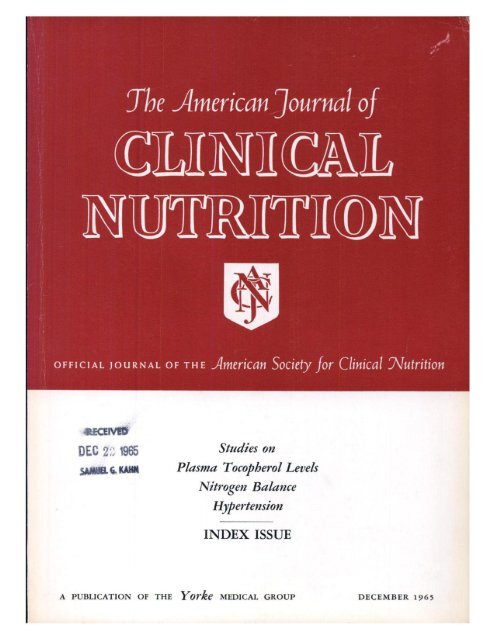在一项队列研究中,进餐时间与肥胖措施和肠道微生物组特征的关联:西班牙裔社区健康研究/拉丁裔研究
IF 6.5
1区 医学
Q1 NUTRITION & DIETETICS
引用次数: 0
摘要
背景:限时饮食可能通过限制热量、昼夜节律或影响肠道微生物组(GMB)来帮助控制体重。身体活动(PA)也起着作用,因为进食窗口(EW,每天第一次和最后一次进食之间的时间)较长的人可能更活跃。膳食时间、肥胖、PA、久坐行为(SB)和GMB特征之间的关系对西班牙裔/拉丁裔人群很感兴趣,他们经历了心脏代谢疾病的高负担。目的:我们探讨了EW与能量摄入和加速度计测量的活动之间的关系,并评估了更长EW和更晚的摄入中点(MOI,摄入中点时间)是否与西班牙/拉丁裔成年人的肥胖和GMB差异有关。方法:使用前瞻性西班牙裔社区健康研究/拉丁裔研究的数据(n = 11,778名参与者,具有有效的24小时饮食回忆和加速度计数据,没有计划外体重减轻,BMI≥18.5 kg/m2;n = 1925 (GMB数据),我们探讨了EW, SB和能量摄入之间的关系。我们使用多变量线性回归模型来研究EW或MOI与肥胖测量和GMB特征之间的关系,并根据临床、行为和人口统计学特征进行调整。结果:睡眠时间较长的人SB更少,能量摄入更多,这表明一些人可能会在摄入和消耗之间取得平衡。在包括能量平衡在内的调整后,每小时的EW与0.29%的BMI升高相关(95%可信区间[CI]: 0.07, 0.51;P = 0.011)。较长的EW和高热量EW (EWC, EW,仅含热量膳食)与几种肥胖相关的GMB类群相关,如链球菌(富含,β: 0.04;95% CI: 0.01, 0.07,为EW)。MOI与肥胖或GMB特征无显著相关性。结论:较短的运动时间可能促进健康体重,但与较短的运动时间相比,较长的运动时间往往有更大的活动,这可以平衡他们更多的能量摄入。EW和EWC可能会影响GMB的特性。本文章由计算机程序翻译,如有差异,请以英文原文为准。
Association of meal timing with adiposity measures and gut microbiome characteristics in a cohort study: the Hispanic Community Health Study/Study of Latinos
Background
Time-restricted eating may help control weight through caloric restriction, circadian rhythm, or influence on the gut microbiome (GMB). Physical activity (PA) also plays a role, as people with a longer eating window (EW, time between first and last daily intake) may be more active. The associations between meal timing, adiposity, PA, sedentary behavior (SB), and GMB characteristics are of interest in Hispanic/Latino persons, who experience a high burden of cardiometabolic diseases.
Objectives
We explored the relationship of EW with energy intake and accelerometer-measured activity and assessed whether a longer EW and later midpoint of intake (MOI, midpoint time of intake) are associated with adiposity and GMB differences in Hispanic/Latino adults.
Methods
Using data from the prospective Hispanic Community Health Study/Study of Latinos (n = 11,778 participants with valid 24-h dietary recall and accelerometer data, no unplanned weight loss, and BMI ≥ 18.5 kg/m2; n = 1925 with GMB data), we explored the relationship between EW, SB, and energy intake. We used multivariable linear regression models to study the relationship between EW or MOI and adiposity measures and GMB characteristics, adjusted for clinical, behavioral, and demographic characteristics.
Results
Those with longer EW tended to have less SB and greater energy intake, suggesting that some individuals may balance greater intake with greater expenditure. After adjustments including energy balance, each hour of EW was associated with 0.29% higher BMI (95% confidence interval [CI]: 0.07, 0.51; P = 0.011). Longer EW and caloric EW (EWC, EW, caloric meals only) were associated with several obesity-associated GMB taxa, such as Streptococcus (enriched, β: 0.04; 95% CI: 0.01, 0.07, for EW). MOI was not significantly associated with adiposity or GMB characteristics.
Conclusions
Shorter EW may promote healthy weight, but some individuals with longer compared with shorter EWs tend to have greater activity that could balance their greater energy intake. EW and EWC may influence GMB characteristics.
求助全文
通过发布文献求助,成功后即可免费获取论文全文。
去求助
来源期刊
CiteScore
12.40
自引率
4.20%
发文量
332
审稿时长
38 days
期刊介绍:
American Journal of Clinical Nutrition is recognized as the most highly rated peer-reviewed, primary research journal in nutrition and dietetics.It focuses on publishing the latest research on various topics in nutrition, including but not limited to obesity, vitamins and minerals, nutrition and disease, and energy metabolism.
Purpose:
The purpose of AJCN is to:
Publish original research studies relevant to human and clinical nutrition.
Consider well-controlled clinical studies describing scientific mechanisms, efficacy, and safety of dietary interventions in the context of disease prevention or health benefits.
Encourage public health and epidemiologic studies relevant to human nutrition.
Promote innovative investigations of nutritional questions employing epigenetic, genomic, proteomic, and metabolomic approaches.
Include solicited editorials, book reviews, solicited or unsolicited review articles, invited controversy position papers, and letters to the Editor related to prior AJCN articles.
Peer Review Process:
All submitted material with scientific content undergoes peer review by the Editors or their designees before acceptance for publication.

 求助内容:
求助内容: 应助结果提醒方式:
应助结果提醒方式:


